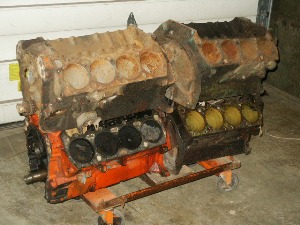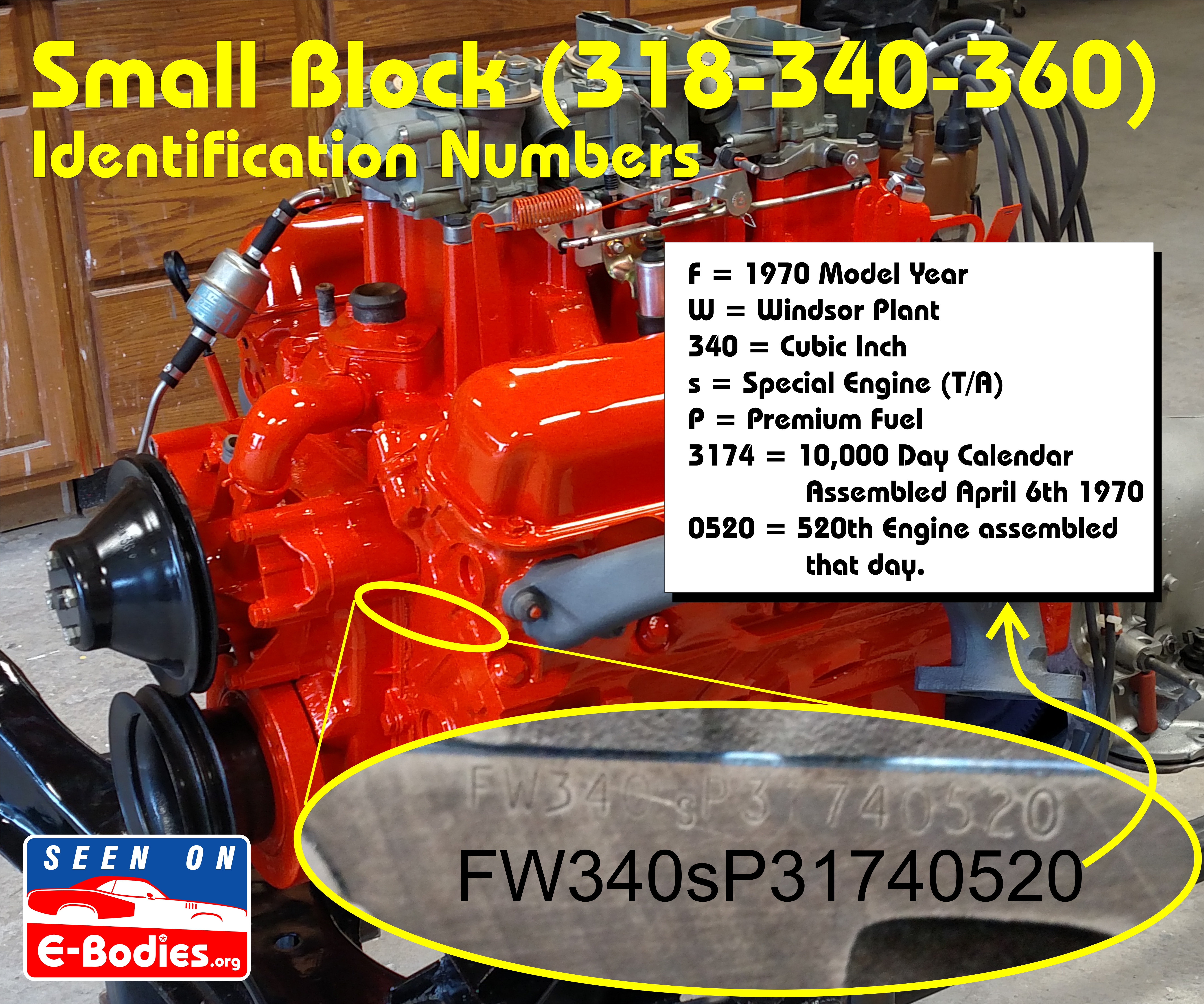Mopar 340 Engine Serial Numbers
The Amazing Mopar (Dodge/Plymouth) 340 V8 Engine Chrysler’s 340 cubic inch V8 was one of the best engines of the 1960s and 1970s for performance enthusiasts. It had high-flow heads, big ports, a two-level intake manifold, and a six-barrel option (three two-barrel carbs). The engine combined high power and relatively light weight, a fine combination in the Plymouth Duster and Road Runner. The design was guided by Tom Hoover, later known as “father of the Hemi;” based on engine analyses, he set the bore size at 4.04”, though the cylinders were just 4.46” apart. The valves were as large as possible, which meant moving the spark plugs ever so slightly (0.08”) further out. When the 340 came out in late 1967, it was a street fighter from the start.
Separating the 340 from the standard-performance were not just 22 cubic inches, but also: • a dual timing chain with a windage tray to improve top end engine RPM by keeping the crank counter weights from churning the oil in the pan. 1968 specs 1968 318 V8 () 1968 340 V8 Carburetor type 2-bbl. Carter AVS 4-bbl Horsepower 230 @ 4400 rpm 275 @ 5000 rpm Torque, lbs.-ft. 340 @ 2400 rpm 340 @ 3200 rpm Compression ratio 9.2 to 1 10. Buku Rouhani Kristen Gratis Pdf Samenvoegen. 5 to 1 Bore x Stroke 3.91 x 3.31 4.04 x 3.31 Fuel Regular Premium From Plymouth dealer book — gross horsepower, torque listed. 1970-71 engines were painted orange; they changed to blue very late in the 1971 model year; the camshaft on automatics had a 268° intake and 276° exhaust opening duration, with 44° overlap (manuals had 276° intake, 284° exhaust, 52° overlap). Valve lift was 0.430” intake, and 0.445” exhaust. The 10.3:1 compression ratio (according to 1971 brochures) was far above the 318’s 8.8 and the 360’s 8.7.
A six-barrel version (with three two-barrel carburetors) brought higher-performance heads, new valve covers, and material added to the bulkheads to allow for four-bolt main bearing caps. This one used an unsilenced air cleaner, rather than the dual-snorkel one used in the four-barrel; it was only sold in the Plymouth AAR ’Cuda and Dodge Challenger T/A.
For the 1971 cars, the 340 (and the 360) came with the “J” type heads, using a single casting, with different machining for the different sized valves. 360 heads were used in the 1970 340 Six-Pack AAR/TA, which had the same size valves. 1971 specs Four-barrel 3 x Two-barrel Gross Horsepower 275 @ 5000 rpm 290 @ 5,000 Net Horsepower 235 @ 4,400 250 @ 4,800 Torque, lbs.-ft. 340 @ 3200 345 @ 3,400 Net (SAE) torque 305 @ 2,800* 310 @ 3200* 325 @ 3,400 Cam intake, exhaust, overlap 268° - 276° - 44° * 1971 press release stated 305 lb-ft net at 2800 rpm, 1971 brochure listed 310 @ 3200.


** According to preliminary 1971 materials To meet 1972 model-year emissions rules, the 340 was detuned; the compression was dropped to 8.5:1, and the intake valves were smaller. The 340 was still the LA power king, with 240 gross horsepower and 290 lb-ft of toruqe — when the 360 was rated at 175 hp and 285 lb-ft.
How to Decode your MoPar. Decoding Chart. A88 Duster 340 Interior Decor Group. B/RB Engine Block Casting Numbers. 1852 029: 413: RB. Everything you've ever wanted to know about. On page 198 of the Mopar engines. Was used to stamp the engines serial numbers. When an engine has.
The engine gained 5 pound-feet of torque in the 1973 model year; that would be its last performance. The lighter side is that some of the 340’s components were used in a high-output version of the closely-related in the 1974 cars. The 360 shot up from 175 hp to 245, in the four-barrel high performance version, which got the old 340 cam — even if the intake valves were still 1.88 inches.
Chrysler’s Pete Hagenbuch wrote: I drove a 1972 with the 340 for a year. For just driving pleasure that was my favorite muscle car.
The car was as light on its feet as most sports cars. My commute was made a joyful dash in that car. My 1971 Duster 340 was a bear in a straight line but try a little throttle in a turn and wheelhop off the road. I pulled out to pass a slow guy going about 40 on my way to work. Did a 3-1 kickdown, hit a bump, and ended up looking him right in the eyes! He refused to move until I was almost out of sight. As for design, all I can tell you is big valves, a big cam, and a high compression ratio.
Micomlar wrote: “The windage trays supposedly resulted in an approximately 650 to 800 fouth gear top end finish improvement, but were suspected to cause some damage as they starved some critical bottom end components, unless the engine was in peak mechanical shape. I own three 340s; one engine has genuine X heads and the other two have AAWJ 360 with the 1.88 intakes removed and the 2.02 stainless valves and the intake runners worked to match the larger foot print X head gasket outline.
340 V-8 engine parts identification (Steve Silver) Some of the 1970 340 Six-Pack engines had heads with a U or O casting letter in addition to the J, but they were still the same part number (the T/A head had the intake valve pushrod holes drilled in a offset location). Valve covers for 340 engines were different than 318 valve covers.
Since the 340 carb was a 4 barrel, it was wider and the carb linkages caused interference with the spark plug wires, so they raised the drivers side wire holder up about 2.5' higher than the 318, to clear the linkages. It also pushed the choke well boss over close to the passenger side valve cover close to the wiring and vacuum advance hose that runs along the valve cover, so they added a rubber coated curved heat shield to the side of the valve cover to protect the wiring. This is how you can tell 340 valve covers from 318 valve covers at a swap meet. Autoplay Menu Designer 5 Keygen Download more. T/A 340 valve covers were almost identical to standard 340 valve covers, except the spark plug wire holders were located about an inch farther back toward the rear. Mopar 340 V-8 Engine - Carburetors and Cranks • Mike Sealey: T/A engines would be the rare 3x2bbl '340 Six Pack' engines seen only in the. These have other mechanical besides the three deuce carb setup.